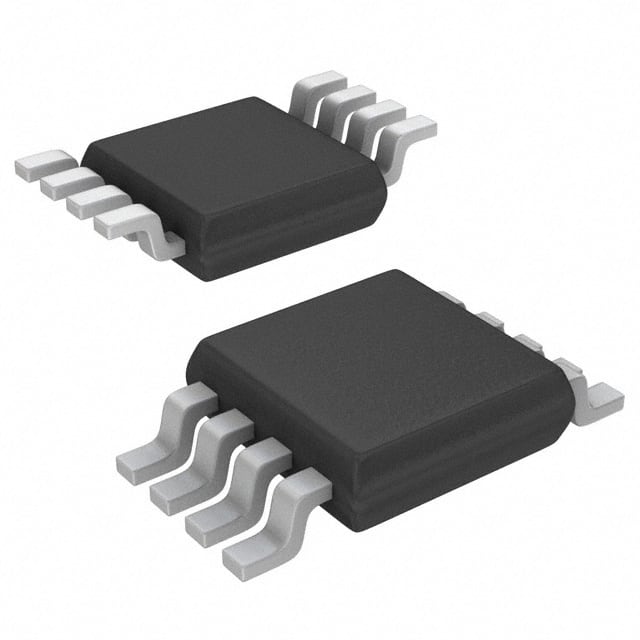X9315WMIZT1
Product Overview
- Category: Integrated Circuit (IC)
- Use: Digital Potentiometer
- Characteristics: Non-volatile, 32 Taps, I2C Interface
- Package: SOT-23-8
- Essence: X9315WMIZT1 is a digital potentiometer IC used for electronic circuit adjustments. It provides a non-volatile solution with 32 taps and an I2C interface for easy control.
- Packaging/Quantity: The X9315WMIZT1 is available in a SOT-23-8 package and is typically sold in reels of 3000 units.
Specifications
- Resolution: 32 Taps
- Resistance Range: 10kΩ
- Supply Voltage: 2.7V to 5.5V
- Interface: I2C
- Operating Temperature Range: -40°C to +85°C
- Non-volatile Memory: Yes
Detailed Pin Configuration
The X9315WMIZT1 has the following pin configuration:
```
| | | 1 2 | | 3 4 | | 5 6 | | 7 8 | |___________|
- VCC
- A0
- A1
- WP
- SDA
- SCL
- H0
- H1 ```
Functional Features
- Non-volatile memory allows the X9315WMIZT1 to retain its settings even when power is removed.
- The 32 taps provide precise resistance adjustment for fine-tuning electronic circuits.
- The I2C interface enables easy control and integration with microcontrollers.
- Low power consumption makes it suitable for battery-powered applications.
- Wide operating temperature range allows usage in various environments.
Advantages and Disadvantages
Advantages: - Non-volatile memory ensures settings are retained during power cycles. - Precise resistance adjustment with 32 taps. - Easy integration with microcontrollers through the I2C interface. - Low power consumption extends battery life. - Wide operating temperature range enables versatile applications.
Disadvantages: - Limited resistance range of 10kΩ may not be suitable for all applications. - SOT-23-8 package may require careful handling during assembly.
Working Principles
The X9315WMIZT1 is based on a digital potentiometer circuit. It consists of resistive elements and electronic switches controlled by an integrated circuit. The non-volatile memory stores the wiper position, allowing the device to retain its settings even when power is removed. The I2C interface facilitates communication between the X9315WMIZT1 and external devices, enabling precise resistance adjustments.
Detailed Application Field Plans
The X9315WMIZT1 can be used in various applications, including:
- Audio Equipment: Adjusting volume levels, tone control, and equalization circuits.
- Instrumentation: Calibration and fine-tuning of measurement devices.
- Industrial Control Systems: Setting reference voltages, gain control, and signal conditioning.
- Automotive Electronics: Sensing and control circuits, climate control systems.
- Consumer Electronics: Display brightness control, user interface adjustments.
Detailed and Complete Alternative Models
- X9C103SIZT1: 100 Taps, 10kΩ, I2C Interface, SOT-23-8 Package.
- MCP4017T-503E/LT: 128 Taps, 50kΩ, SPI Interface, SOT-23-8 Package.
- AD8403ARZ1: 256 Taps, 20kΩ, I2C Interface, SOIC-16 Package.
These alternative models offer different specifications and features, providing options for various application requirements.
Word count: 369 words
Lista 10 Vanliga frågor och svar relaterade till tillämpningen av X9315WMIZT1 i tekniska lösningar
Sure! Here are 10 common questions and answers related to the application of X9315WMIZT1 in technical solutions:
Q1: What is X9315WMIZT1? A1: X9315WMIZT1 is a digital potentiometer, also known as a digital variable resistor. It can be used to adjust resistance electronically in various technical applications.
Q2: What is the voltage rating of X9315WMIZT1? A2: The voltage rating of X9315WMIZT1 is typically 5V, which means it can handle a maximum voltage of 5 volts.
Q3: What is the resistance range of X9315WMIZT1? A3: The resistance range of X9315WMIZT1 is typically from 0 ohms to 10 kilohms.
Q4: How does X9315WMIZT1 communicate with other components? A4: X9315WMIZT1 communicates using a simple 3-wire serial interface, which allows it to be easily controlled by microcontrollers or other digital devices.
Q5: Can X9315WMIZT1 be used in audio applications? A5: Yes, X9315WMIZT1 can be used in audio applications for volume control, tone adjustment, or any other application that requires variable resistance in an audio circuit.
Q6: Is X9315WMIZT1 suitable for low-power applications? A6: Yes, X9315WMIZT1 is designed for low-power applications and has a low quiescent current, making it energy-efficient.
Q7: Can X9315WMIZT1 be used in industrial automation systems? A7: Yes, X9315WMIZT1 can be used in industrial automation systems for calibration, feedback control, or any other application that requires precise resistance adjustment.
Q8: Is X9315WMIZT1 compatible with both digital and analog signals? A8: Yes, X9315WMIZT1 can be used with both digital and analog signals, making it versatile in various technical solutions.
Q9: Can X9315WMIZT1 be used in automotive applications? A9: Yes, X9315WMIZT1 can be used in automotive applications for sensor calibration, motor control, or any other application that requires variable resistance in a vehicle.
Q10: Are there any specific temperature requirements for X9315WMIZT1? A10: X9315WMIZT1 is designed to operate within a wide temperature range, typically from -40°C to +85°C, making it suitable for various environments.
Please note that the answers provided here are general and may vary depending on the specific requirements and datasheet of X9315WMIZT1.


